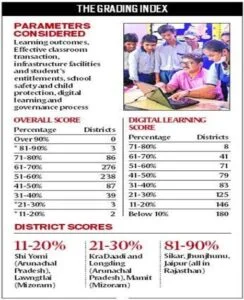Economics, Social Issues
In News: The Department of School Education and Literacy, Ministry of Education (MoE) has released the Performance Grading Index for Districts (PGI-D)
- PGI-D assesses the performance of school education system at the district level by creating an index for comprehensive analysis
- It is based on 83 indicators grouped in six categories.
- These categories are outcomes, effective classroom transaction, infrastructure facilities and student’s entitlements, school safety and child protection, digital learning and governance process.
- PGI-D grades the districts into ten grades — highest achievable grade is Daksh, which is for districts scoring more than 90% of the total points in that category or overall.
- Utkarsh category is for districts with scores between 81-90% followed by Ati-Uttam (71-80%), Uttam (61-70%), Prachesta-I (51-60%), Prachesta-II (41-50%) and Pracheshta III(31-40%)
- The lowest grade in PGI-D is called Akanshi-3 which is for scores upto 10% of the total points.
- Rajasthan’s Sikar is the top performer followed by Jhunjhunu and Jaipur
- The three districts have figured in the Utkarsh category with Junjhunu scoring the maximum in learning outcomes.
- The other States whose districts have performed best in the latest index are Punjab with 14 districts in Ati-uttam grade followed by Gujarat and Kerala with each having 13 districts in this category.
- There are 12 States and Union Territories which don’t have even a single district in the Ati-uttam and Uttam categories and these include seven of the eight States from the northeast region.
- The report states that since none of the States have districts in the top category there was a need for further improvement in the years to come.
Digital learning
- The PGI-D for 2019-20 shows that schools across India performed poorly under the category of digital learning, which threw up the lowest scores compared to the other parameters which were considered while creating the index.
- In the index, as many as 180 districts scored less than 10 per cent on digital learning, 146 districts scored 11 to 20 per cent, while 125 districts had scores between 21 and 30 per cent.

- There is a clear rural-urban divide in the area of digital learning.
- For instance, while districts in cities like Chandigarh and Delhi scored between 25 and 35 out of 50, places like Bihar’s Araria and Kishanganj scored as low as 2
- The district-wise performance on digital learning was drawn up based on the number of schools with computers/laptops, Internet facility, student-to-computer ratio and percentage of teachers trained to use and teach through computers.
Source: The Hindu
Previous Year Questions
Q.1) The Global Competitiveness Index is published by? (2019)
- International Monetary Fund
- United Nations Conference on Trade and Development
- World Economic Forum
- World Bank














